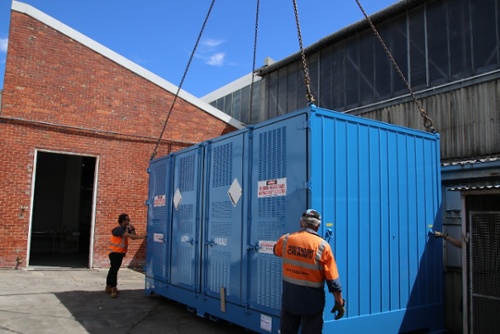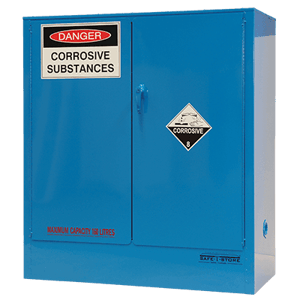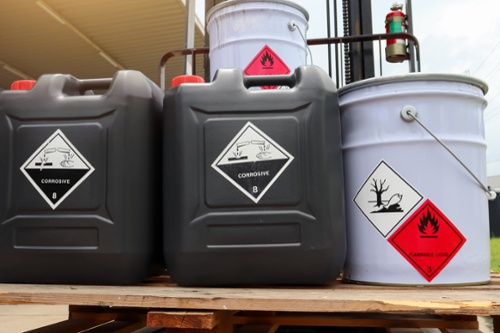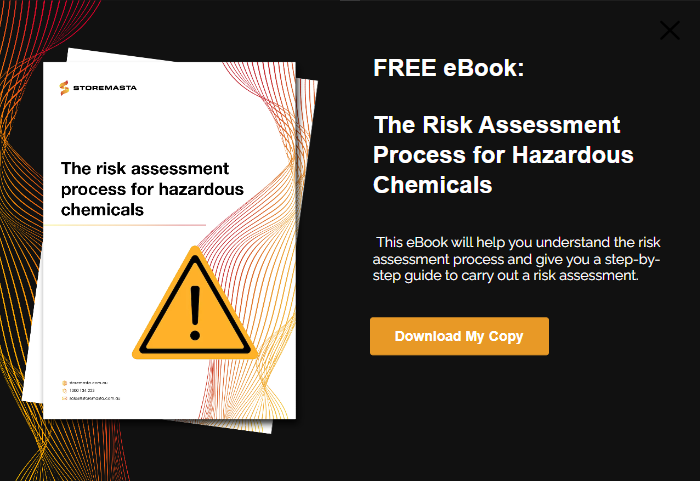Have you just bought a corrosive storage cabinet or installed a chemical storage container outdoors? Then this blog is written specifically for you. If you’re new to dangerous goods storage, you may not know that cabinets and outdoor storage containers require regular inspections, housekeeping and maintenance in order for them to stay safe — and meet your ongoing compliance obligations. But what do you need to tick off when inspecting your corrosive chemical stores?
From the stacking of your corrosive packages to the emptying of your spill sump, we’ll detail the general points you need to consider when developing a checklist for your corrosive cabinet inspections.
Why Do You Need A Checklist?
There are many factors that can inhibit and reduce the state-of-the-art controls that are featured in your corrosive storage cabinet or outdoor chemical storage container.
Regular use, accidental damage, changes in workplace practices and even changes in inventory may affect how your cabinet is operating and undermine its safety.

Developing a checklist for your controls with your team allows you to actively ensure compliance in handling and storage areas.
While your store may be 100% compliant when it leaves the manufacturer, the process of installing, using and cleaning the equipment may or may not be compliant.
By regularly inspecting your safety cabinets and outdoor chemical stores, you are ensuring that they are in good working condition and continuing to meet the requirements of WHS Regulations and Australian Standards.
This is true, regardless of whether they’re corrosive cabinets or another type of dangerous goods cabinet. All controls must be inspected, reviewed and maintained to achieve ongoing chemical compliance.
What Do WHS Regulations Say?
Section 37 of the WHS Regulations, it explains your duty in regard to maintaining chemical controls for hazardous substances:
37 Maintenance of control measures
A duty holder who implements a control measure to eliminate or minimise risks to health and safety must ensure that the control measure is, and is maintained so that it remains, effective, including by ensuring that the control measure is and remains:
(a) fit for purpose; and
(b) suitable for the nature and duration of the work; and
(c) installed, set up and used correctly.
To ensure that your corrosive stores are functioning as they should, regular inspections (preferably weekly, at a minimum) are required to maintain safety and chemical compliance.
In the next section, we’ll be explaining the key points that you should incorporate in your corrosive substance store inspection checklist.
Installation
Has the cabinet or store been installed correctly? An incorrect installation can result in a range of safety issues including spillage and the release of hazardous vapours.

Inspecting the installation of your cabinet or container is part of your compliance obligations.
Without a compliant cabinet or store installation, you won’t be able to maximise the effectiveness of the chemical controls that are built into your corrosive substance store.
Check these points on your next inspection:
- Is the cabinet or outdoor store in a convenient, safe location?
- Does the floor or ground offer a flat, even surface for installation?
- Are there any chemical hazards located nearby which should be isolated and removed?
- If outdoors, does the store meet the separation distances from protected and public places?
- If indoors, does the cabinet meet the requirements (Section 4.6.3 of AS 3780:2008) that relate to the maximum quantity of corrosive substances kept in a single cabinet?
- Is the store or cabinet located close to emergency decontamination facilities?
- Does the location impede escape in the event of a fire?
IMPORTANT: We recommend conducting an onsite risk assessment before you purchase and install a corrosive cabinet or outdoor corrosive container. It’s vital that any potential hazards are noted and dealt with before you install your dangerous goods storage equipment.
Integrity
The integrity of your store will be determined by how it was delivered, installed and used by your staff.
As part of your regular cabinet or store inspections, check for obvious signs of damage or wear by checking that
- The doors close properly
- The locking mechanism of the outdoor store (or the lock on the cabinet) works as it should
- Spill sump is undamaged and working correctly
- Shelving height is suitable for the packages kept
- Shelving is even and stable
- The paint coating is still intact and undamaged
- The store or cabinet is stable
- If a mechanical ventilation system is installed, that it is working correctly and meets all necessary compliance obligations
Chemical Resistant Materials
As corrosive substances can degrade materials including sheet steel, protection within indoor cabinets and outdoor stores is vital.

As corrosive cabinets feature chemically-resistant PVC linings, you must inspect these to ensure that they remain effective.
When inspecting your corrosive stores, make sure that your:
- PVC spill trays on cabinet shelves are in good condition
- PVC sump lining is in place, clean and without damage
For cabinets that are made of polyurethane, make sure that the material is
- Without tears, dents or other signs of damage
- That there is no warping of the material
- Clean and clear of chemical residue
REMEMBER: When it comes to the storage of corrosive substances in cabinets, there are two options available: metal and polyurethane. Highly corrosive chemicals are generally stored in poly cabinets to avoid the degradation of construction materials due to corrosive vapours.
Segregation
While segregating dangerous goods from other incompatible classes is part and parcel of chemical storage, Class 8 corrosives must also be segregated in terms of acids and bases (including alkali).
Make sure that your inspection checklist ticks off:
- Acids and bases are stored separately; or
- They are segregated within a polyethylene cabinet in the correct fashion; and
- The store does not include chemical packages other than Class 8 Dangerous Goods
Corrosive Packages
If your chemical packages are stored in a dangerous or haphazard fashion, there is a real risk that the packages may fall, become damaged, and cause a corrosive chemical spill.

How you use and store your corrosive chemical packages can impact the likelihood of a chemical spill.
To make sure that your staff are following the correct stacking and loading procedures, inspect the store to ensure that:
- Corrosive packages are compliant/made of chemically-resistant materials
- There are not old, damaged, split or leaking containers
- All packages are correctly labelled
- Containers are secured with lids or taps
- The use by date of corrosive chemicals is within the acceptable date range
- Stacked packages are not liable to topple
- Any packaging (cardboard, plastic, tape etc) has been discarded prior to the chemical packages being placed in storage
- The cabinet is not loaded past its maximum storage capacity (see the capacity rating listed on the front of the cabinet or store)
- Packages are sitting neatly on the shelves and not prohibiting the doors from closing and locking properly
- Every corrosive substance within the store meeting the dangerous goods segregation requirements
- Each substance has an applicable Safety Data Sheet within the SDS document holder (ideally, attached to the cabinet or store)
- The Register of Hazardous Chemicals is up-to-date
Housekeeping of Corrosive Cabinets and Stores
Developing a strong strategy for housekeeping is an important part of maintaining a chemically compliant workplace.
As part of your regular inspections, check that the following tasks have been completed by your housekeeping team:
- There is no rubbish, materials or other items on top of, near or within your store
- All corrosive packages are stored neatly, with stacks not liable for collapse
- Containers, drums, bottles and other packages are wiped down
- Empty containers are disposed of in a compliant manner
- Shelving, walls and the ceiling of the cabinet or store are wiped down regularly
- The cabinet is kept closed and locked after housekeeping duties
- PVC linings are wiped down and inspected for damage
- Spill sumps are safely emptied and cleaned out (as soon as a spill occurs)
Also consider that:
- There are no lightbulbs or light fixtures in the area which require replacement
- All DG and hazard signage is correct, clean and visible
- The maximum capacity sign and manufacturer’s details are intact
- Emergency decontamination facilities are clean and in good working order
- There are no work practices in the area which could affect the safety and compliance of the store ie. such as being in the way of vehicle traffic which may result in impact damage, or incompatible substances being left near the store
- Any issues with the store (or its components) are noted and communicated with the supervisor, so corrective action may be taken
IMPORTANT: While inspecting and maintaining your chemical controls is part of your duty under WHS Regulations, so is the review of your controls. Make sure that your team review your existing chemical control measures to ensure that they stay efficient and effective as your workplace grows and changes.
Inspecting Corrosive Cabinets and Outdoor Chemical Containers
While we’ve highlighted some of the most important points to include in your inspection checklist, you can always tailor your list to include other factors that may be unique to your workplace. We also strongly recommend familiarising yourself with the WHS Regulations and Australian Standards to ensure that you’re continually meeting your compliance obligations.
To learn more about the safe storage of corrosive substances — or any type of dangerous goods — you can access our free eBook. The Risk Assessment Process For Hazardous Chemicals will introduce you to our 4-step risk control methodology, which can be easily applied to your workplace. Get a copy of our free guide today by simply clicking on the below image.
Joining the team as a Dangerous Goods Storage Consultant, Melissa Hampton became Storemasta's Marketing Manager in late 2021. With extensive knowledge and experience in chemical compliance, Melissa is responsible for leading the Marketing team and helping shape their marketing strategy. In her spare time, you can find Melissa hiking, swimming and enjoying the great outdoors in beautiful north-west Tasmania.
